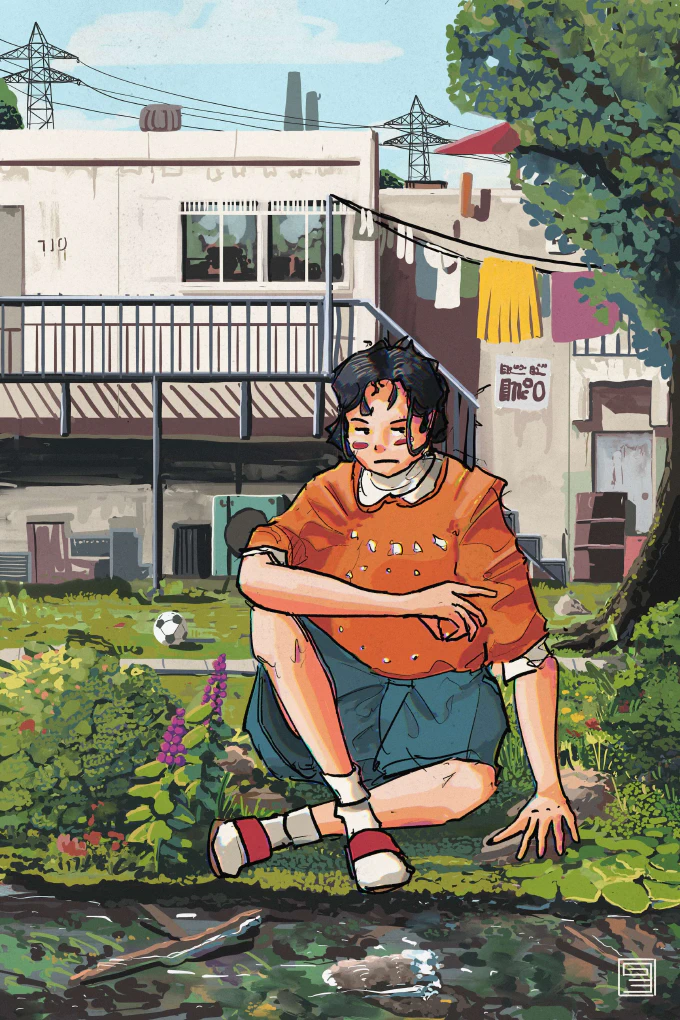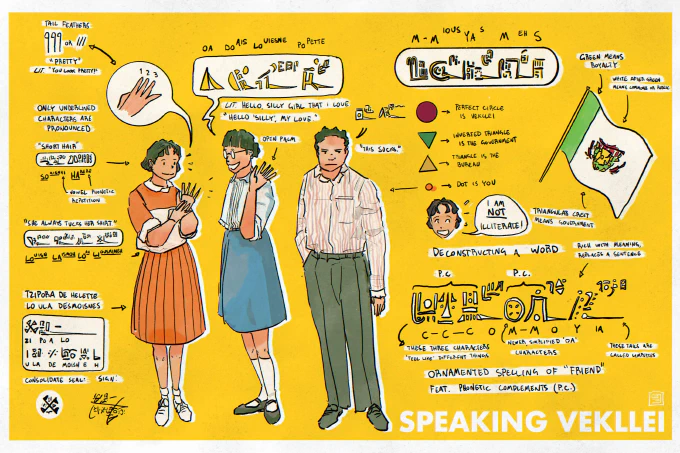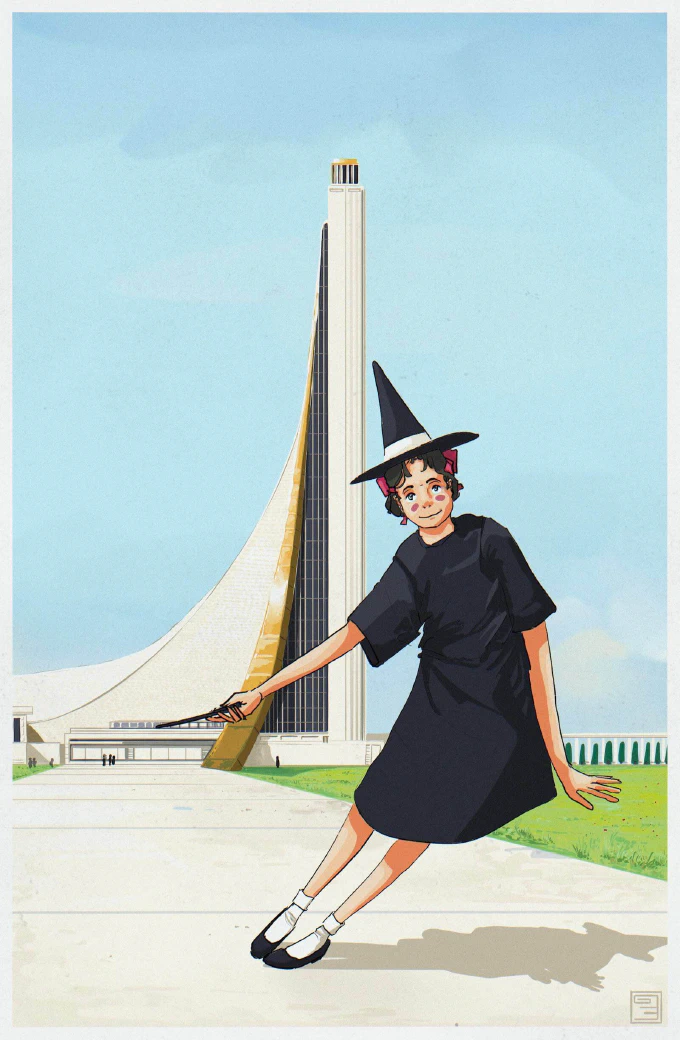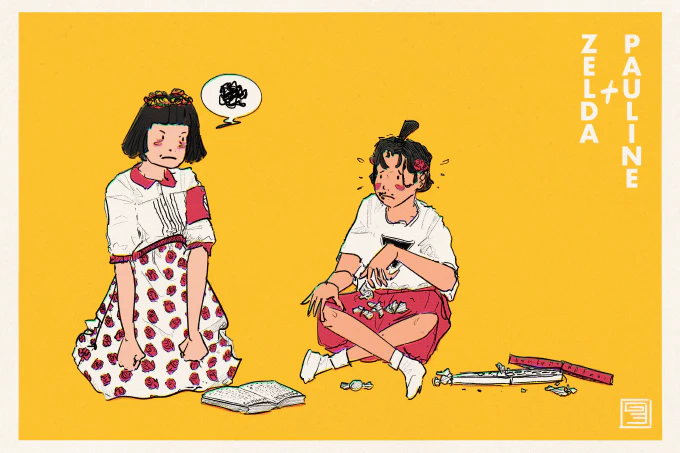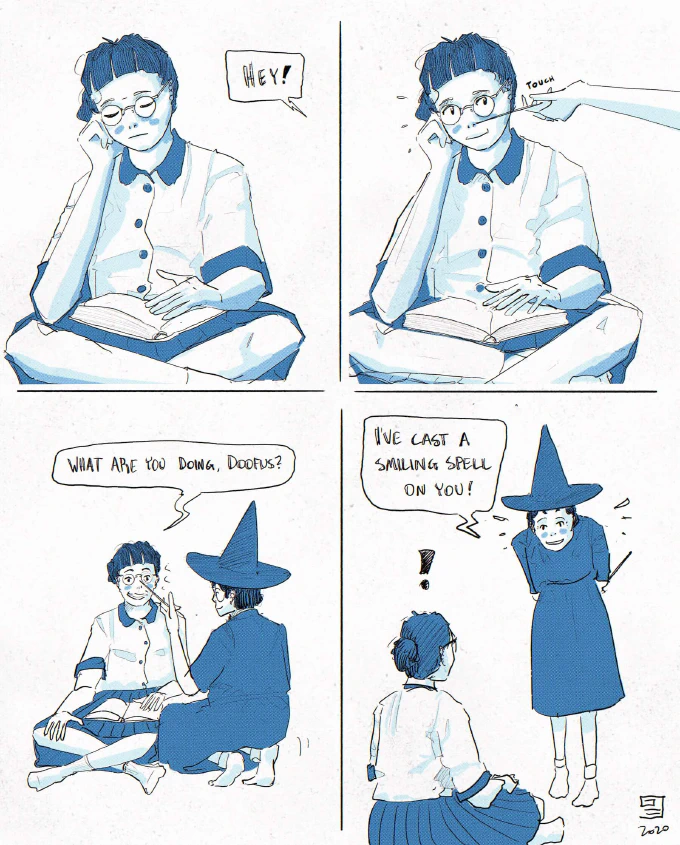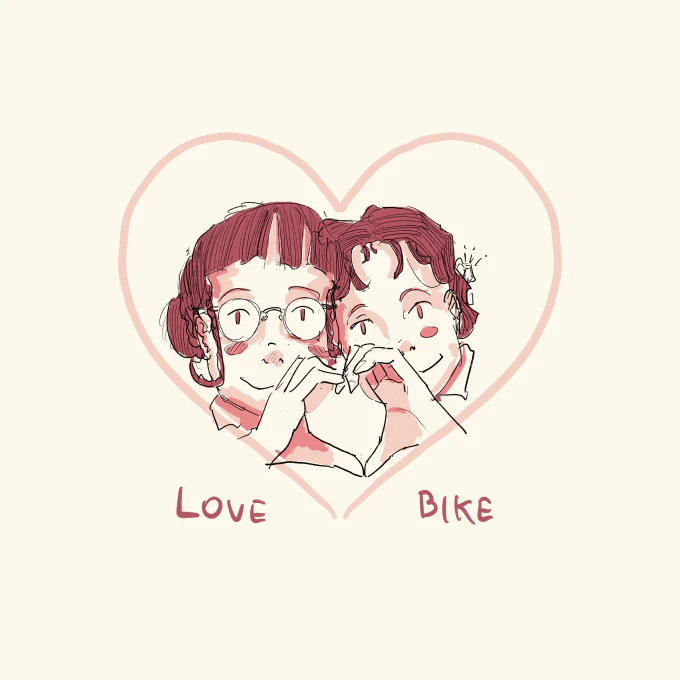NEW Story: Sunday Morning
The Atlantic Bulletin
From the Editor #
Welcome to the sixth issue of The Atlantic. November’s a bitch.
This was a hard month, evidenced in part by the smaller number of posts. Personal problems and some bad news are enough to derail plans, I’m afraid, and so other things had to take their place. November saw an increase in articles on MillMint.net and polish to the site, a whole lot of little sketches, as well as plans for a Patreon milestone reward and some private work on the comic.
The comic’s coming, by the way. I know it’s a little late and a little quiet, but it’s hard yakka and I’m doing my best. I’m writing this in early December, and I can tell you already that the winds are changing — and man do I have a great month of stuff planned, including comic drafts and pins for Patrons.
November saw two big “article-type” posts about language and city planning — sister articles on religion and nature will arrive in December. These posts help form the full-length wiki articles on the website, which will be comprehensive resources for understanding Vekllei. How exciting! Also expect a few more snapshots of life before the comic pages are released to Patrons in the coming weeks. As always, thanks for your patience, dear reader.
Finally, if you would like to contribute to The Atlantic with writing, art or reviews relevant to the spirit of petticoat ideology, please contact Hobart at [email protected] before the 30th of November.
Thank you for supporting Vekllei, and best wishes.
Hobart Phillips Enjoy — 楽しんで
I. News & Announcements #
- Life can be hard sometimes. But it can also get better!
- I’m planning a full, complete site launch in the new year! It’ll be a great wiki and archive of all content related to the project, and will really benefit my work overall. The comic will also be hosted via the site, though I’m still figuring out the particulars on that one.
- In November, I was interviewed by Media Tackle about Vekllei and utopian worldbuilding, and I look forward to sharing that interview with you all soon.
- My work on utopian worldbuilding in the films of Studio Ghibli will soon be hosted in the Essays section of the website.
- I love you.
II. Tzipora-watch #
In November of 2075, Tzipora would begin work as an amateur contributor to the underground ‘zine Kid Comix, a satirical and often crude publication circulated mostly among its contributors and die-hard comix fans. This would get her in trouble more than once, especially after members of the Montre University faculty discovered her caricatures of them, but she would always look back on her time with the ‘zine fondly. In many ways, it introduced her to publishing and would lead to her employ at the Montre University Tribune, where she would eventually serve as Editor-in-Chief.
III. Vekllei Fact of the Month #
All fishing trawlers in Vekllei — that is to say, fishing vessels above a certain size for large-scale commercial trawling — are owned and operated by the navy. The seas in Vekllei’s exclusive economic zone are mostly fished by small craft laying lines and nets, but the deeper peripheral waters that surround the zone are as contentious as they are well-stocked with fish. To ensure the security of their trawlers and preserve access to these valuable and contested waters, trawlers are often guarded by navy ships — a handful of trawlers are even equipped with guns!
IV. WordBook #
Gouisvenpan — pronounced “gwee-ven-pan,” Gouisvenpan describes a state or territory that is divided between two political powers as a result of treaty or civil war. Tzipora’s middle-school-era homeland, the United States, is currently suffering from Gouisvenpan across many of its seceding states.
V. The Bulletin #
Coming to Grips #
📖 Published 30th November 2020 | Read here | Archived here
She would spend a long time by the rivulet that ran behind her apartment. She would do the housework and hang the wash out, then watch the water trickle past in the sun.
She tried to open a jar the other day and started to cry when she couldn’t get it open. She never cried once when she saw those things in America, or got beat to shit, but these days she cried over jam. She didn’t know what was going on. Things were getting worse.
She caught her reflection in the rivulet’s water. It provoked a nausea. She was so tired. What would stop her from plunging her face into the river until she slipped right in? Would she drown and float away, never to be seen again? Or maybe, in a miracle, she might grow gills and fins and swim away, her life-force put to better use as a fish or turtle.
How do you resolve an ache to confess sadness to someone and the instinct to protect your emotions? It wasn’t in her nature to tell people about her feelings. On some level, she looked down on it; every cell of her body told her to suffer in silence. She wore the same clothes every day. Why did she wear the same clothes every day?
It is a fierce thing to discover within yourself that which you despise the most. She watched the foam gather around a stick wedged in the bank of the rivulet. If she’d been born elsewhere, into power and wealth rather than girlishness and poverty, she would have made an excellent thug. She wondered how much management she needed. Why was it so hard to live?
She tasted the water from the rivulet and it was cold and sweet, and said a prayer to the rivulet for its purity no matter what happened to her. The wash was dry on the line.
Out of The Ground and Into The Light #
📖 Published 29th November 2020 | Read here | Archived here
NO REALTORS EXCEPT THE STATE ■ THE COUNTY THE AGENT OF THE STATE ■ THE ARCHITECT THE AGENT OF THE COUNTY
It is clear that in Vekllei democracy is a way of living more than it is a form of government. After all, by metrics of representation, the Atlantic nation’s electoral system often sputters and fails, undermined by the bundling of the human and natural votes as equal, and the wildly disproportionate borough system. But if democracy is a way of life and not just a ballot in its box, then we can see democracy acted out all around us in Vekllei.
Cities are living things; they are made up of people hurrying and talking and building. In cities, we see Vekllei’s centralised society/decentralised life contradiction lean towards “deurbanisation” and “local transparency”.
The four principles of Vekllei life are:
- Self-management and self-interest through Sundress Municipalism.
- Classification of property as an independent social organ, like nature.
- Abolishment of currency and currency-substitutes.
- Economic feminisation.
Ranked in order of their immediacy to the average person, we can see that Sundress Municipalism is at the core of Vekllei life. What exactly is Sundress Municipalism? It describes the organisation of Vekllei cities, which are arranged around the following principles:
- Local employment, or “commutelessness.”
- Slumlessness, beautification, and a will to architecture.
- Property stewardship.
- Open air and clean water.
- Land usefulness ("friendliness").
- Private ownership of private needs.
- Public ownership of public needs.
These values are oriented around a deeply Vekllei valuation of space, and the accessibility of place and material to ordinary people. They also reveal some peculiarities in their listing – what constitutes a private and public need, and what constitutes ownership, are deeply spiritual concepts in Vekllei, and their use here relies on uncoded intuition. Let us not forget we are dealing with a state that considers itself to be the human ambassador of the ground on which it sits, and so “public” and “private” include the nonhuman in their metrics. This is how, much to the amusement of foreigners, buildings can and often do “own themselves” in Vekllei. Most ownership is proved by stewardship; the use of space. The person who works the shop and lives above it, owns the shop.
This image depicts the Vekllei city of Adouisneh, the florid culture capital of Vekllei’s Northwest. It is one of the “Five Crowning Cities” of Vekllei, measured by population and cultural significance, and was the site of one of the earliest parliaments in the world, centuries before the monarchy would come to power. You can see here the tension between old-world European planning and new-world Sundress Municipalism in the architecture and layout of this city.
A cactus bloom is beyond any bloom, I think, manufactured by plants anywhere in the world. And there you have an interesting syllogism, haven’t you? The desperate nature of the armed plant and the exquisite, beautiful efflorescence it produces. Something to think about. There you see, revealed, some processes of nature, the significance of which I don’t gather at the moment.
– Frank Lloyd Wright, Nov. 1952
Perhaps urbanised modernity is the cactus, and Sundress Municipalism is the blossom.
It is not that Vekllei’s feminised Municipalism represents a clean departure from how cities look and feel, but instead constitutes a rethinking of urbanism; it is an ideology of homesteads, decentralisation, clean air, food production, arts and crafts, leisure, and the spirit, if not the literal presence of, “disposable income.” It is not enough that a factory should be the property of the people who work in it; a factory should become adjacent to the home, a part of it, designed in ways that benefit the good instincts of ordinary people. Vekllei is a celebration of the architect; automatons may now do a lot of the work, but all design is deeply human.
This is the heart of the dream. Vekllei is not a big enough country to gift each person an acre of land to do with as they wish; it is, however, sophisticated enough to decentralise that “local acre” among the community, cultivating those same values in a modern skyline and allowing the city to flow across the landscape, changing as it responds to the place around it. Ownership is important; stewardship is especially important. By allowing people to own and use land, you give them dignity. Above all, design and architecture are important for the same reason spatiality is important – they give presence to and emulsify work and leisure.
After the mid-twentieth century, modernism began to encircle the world and the architectural and urban images once projected as utopian began to fill real space. In the 1960s this reached a saturation point; utopia was, ironically, realised.
– Karatani Kojin, Architecture as Metaphor, 1983
This occurred because, upon realising that art must be removed from architecture in order to safeguard it against a looming “loss of subject,” avant-garde thinkers methodologically reestablished architecture as ‘construction’ – utilitarian efforts towards grand ideas. With art removed, architecture was able to close in on the inherent placelessness of utopia. In Vekllei, this approach is extant (though diminished by their absurd place-metaphysics) through Newda, the indigenous design ideology that continues to service architecture through social, rather than artistic, methods.
The “big idea” Newda is an agent for, wrapped up in Sundress Municipalism, is very straightforward:
The city should be everywhere and nowhere.
In Adouisneh, despite its thousand years of history, we can see postwar Newda come to life in its integration and decentralisation of the “city” as a living process, moving people and their concerns closer together. Developed only with the consent of the architect, Vekllei has become an architocracy, serving decentralised, pleasant living through bureau monopolies.
Perhaps, after all, it is the necessity of state authority that is the cactus, and the middle-class free lifestyles of Vekllei people that make up the blossom.
How to Speak Vekllei, and A New Website 🎊 #
📖 Published 15th November 2020 | Read here | Archived here
For all you’ve seen of Vekllei and her characters, you’ve never heard a single one of them speak. This post marks a little exploration into the Vekllei language, and a ‘soft launch’ of my website, https://millmint.net. The proper launch will come at the end of the month.
This post will briefly discuss some elements shown in this infographic, but a large article on the language has been drafted here. If you have some interest in constructed language, and some of the more playful aspects of Vekllei’s evolving utopian communication systems, I encourage you to take a look at it. The website is incomplete, and both the articles on characters and Vekllei itself are very incomplete. Otherwise, a growing archive, essays, and issues of the Atlantic Bulletin are all available. Have a poke around, and let me know if anything breaks! The site has dark mode, if you’re a gamer. Just click the moon.
One Language, Many Parts #
To borrow from the article linked above, the Vekllei language has six core systems often referred to as sublanguages. They are as follows:
- Spoken Vekllei, which is everyday spoken language. It draws from two glossaries with different meanings and feelings, called Oa and Loh.
- Topet, which are logographic characters (occasionally characterised as hieroglyphs). Like other pictographic languages, Topet characters can be broken down into repeating components, called Topotte.
- Rapotenne, is the traditional logographic language of names. It is much older than Topet, and has more in common with spiritual runes than modern logography.
- Potenne, lit. “Hand-Talk”, is a sign language that incorporates gestures and signing to add meaning to emotion to spoken language, and occasionally in place of it.
- Upotenne, lit. “Spirit-Hand-Talk”, as the recreation of runes in human form, used limitedly in spiritual ritual.
- Vekllei Semaphore is the codification of colour and shape. Traditionally limited to colour, shape and pattern are now also included in Vekllei Semaphore, in which full sentences can be formed.
In This Picture #
We can see various parts of the Vekllei sublanguages on display, including Topet, Rapotenne, Potenne and Vekllei Semaphore. Before Cobian gets close enough to say hello, Tzipora has already delivered a devastating compliment via a simple three-finger tap to the palm, admiring how she looks. A couple of descriptions of Tzipora written in Topet have been annotated on her left, to demonstrate its use, including a tongue-twister (“She always tucks her shirt” becomes “Louisn Laismoh Loah Liousmineh”). You’ll notice Topet looks especially hieroglyphic, even by pictographic standards.
Tzipora’s full Blood Name is spelled out in Rapotenne below, which is markedly different from Topet in history, characters and grammar. Most formal names in Vekllei employ a seal in place of writing it out in full ornamentation, which has been provided below along with a formal signature. Her signature is entirely pictographic; elements are arranged according to symbolic value, rather than phonological legibility.
On the right, we can see an example of how Semaphore lives up to its name through its presence on flags, reinforcing and communicating information without conventional literacy. Also shown are a handful of basic symbols as they relate to authority, with the landscape of Vekllei superseding all human organs. Their colours matter, and so their meanings are more complex than what is described here – for example, a small black circle refers to a human being, but an orange one refers to an arctic person (usually Vekllei).
Finally, we have a breakdown of the word comiya (also looked at here), which means “friend.” Tzipora and Cobian are comiya, and Moise and Cobian are… sort of comiya. The introduction here of phonetic complements, which are duplicate consonant-pairs used to slightly alter the semantic meaning of a word without changing its pronunciation, allows the idea of a “friend” to be conceptualised in many different ways, to encompass all sorts of relationships. This one here implies a sort of naïve love (by using characters for late autumn, young woman and a glacial beach, all pronounced /k/.)
Limpettes are tails that underline vowel-forms called hieyerette to enhance legibility. Although ornamented Topet has visually distinct consonant-pairings, business Topet does not generally use superscript and so limpettes designate the vowel-form. If you’re a bit lost, that’s okay. It’s in the main article, and I don’t want to make this post too long.
You can imagine then, even with only a handful of examples of language in practice here, how complex Vekllei can become as phonological and semantic meaning compound, combine and seperate in different forms and contexts. The spoken word can be altered by the physical gesture, and the physical gesture can be altered by the written word.
That about wraps up this brief analysis of the infographic above. Thanks for reading, and please let me know here if you have any questions.
Thanks for your patience this month, it’s been slow and hard. With the first pages of the comic around the corner and the site launching at the end of the month, there’s a lot to look forward to. Cheers.
21st Century Witch #
📖 Published 9th November 2020 | Read here | Archived here
When the light shifted just right, the ceramic tiles and concrete footpaths twinkled like water off the back of a swan. 16th Century witches could build a hut in the woods and forage for herbs; 21st Century witches were susceptible to modernist persuasions.
The Demotic Meeting Hall was constructed twenty years prior as the main meeting hall of the National Dockworker’s Union. Situated on the coast, and along the recently-built monorail line to Roya, it dominated the coastline like a mythic lighthouse. Where the cathedrals of Europe built spires to God, Vekllei built towers for dockmen. At 112 meters tall, the hall’s colossal window structures were awesome within, and its massive bronze ornament glittered for miles. It was palatial.
The Dockworker’s Union moved west to Montre at some point, so these days it was simply the Roya Demotic Community Hall. It was used for all sorts of things, not least of which domestic tourism. Its lookout provided views across the North-West Fjords. When Tzipora first arrived in Vekllei, the scale and decadence of it appealed to her enormously. It was depicted on her language booklet, and since then she’d developed a minor fascination with the structure.
She got her chance to visit upon her invitation to a costume party hosted by the Chef’s Concern. Tzipora is a witchy sort of person, and the idea of going as a witch appealed to her. She already had the wardrobe — as Cobian remarked:
“You’ve put on a hat and you’re holding a stick — that’s it.”
“It’s my costume,” Zelda said. “I’m a witch.”
You can see her here attempting to recreate the sumptuous curve of the Meeting Hall in witch form.
More posts soon.
VI. Gallery #
This month’s sketches, presented without context or or standards of quality. The postcards will be included in the August edition. Contact Hobart at [email protected] for full-res versions of any images received in this bulletin.
Update [23.11.2020] #
Chocolate [21.11.2020] #
Tzipora [19.11.2020] #
Cobian [18.11.2020] #
Smile [06.11.2020] #
Love Bike [01.11.2020] #
POSTS THIS MONTH: 5 #
POSTS LAST MONTH: 7 #
Published by MillMint Press. Copyright 2020. To stop receiving these emails send UNSUBSCRIBE to [email protected].
